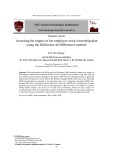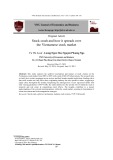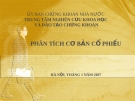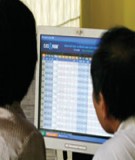
http://www.iaeme.com/IJM/index.asp 64 editor@iaeme.com
International Journal of Management (IJM)
Volume 9, Issue 2, March–April 2018, pp. 64–74, Article ID: IJM_09_02_007
Available online at
http://www.iaeme.com/ijm/issues.asp?JType=IJM&VType=9&IType=2
Journal Impact Factor (2016): 8.1920 (Calculated by GISI) www.jifactor.com
ISSN Print: 0976-6502 and ISSN Online: 0976-6510
© IAEME Publication
AN EMPIRICAL STUDY OF DIVIDEND EFFECT
THROUGH TWO FOLD IMPACT ON SHARE
PRICE
Dr. A. Shanker Prakash
Assistant Professor, Amity Business School,
Amity University Gwalior, Madhya Pradesh
ABSTRACT
There is abundant study available which studied impact of dividend announcement
on share price but this paper is modeled in different manner as dividend
announcement is not one time process but any company takes several procedural
checks to ensure announcement of dividend from conception to declaration and
declaration to distribution which is segregated into two-fold study in the present
paper. The ASRV and CAAR tests applied on five sample companies which declared
final dividend during 2017. The conclusion suggested that dividend announcement is
regular practice of any company which could not change the leading trend & fashion
to market.
Key words: Two-Fold Study, Dividend Effect, ASRV, CAAR, Final Dividend.
Cite this Article: Dr. A. Shanker Prakash, An Empirical Study of Dividend Effect
Through Two Fold Impact On Share Price, International Journal of Management, 9
(2), 2018, pp. 64–74.
http://www.iaeme.com/IJM/issues.asp?JType=IJM&VType=9&IType=2
1. INTRODUCTION
Observing the stock price movement is an area of research that had pulled the attention of
various academicians and scholars time to time. Many economic and non-economic factors
affect the movement of the share price which incorporation is studied through event-study
analysis. A company's liquidity in the present market can be determined by the dividend
announcements made by the company. One of the most meaningful events for research is
dividend announcements. In simple terms dividend is the cost of equity capital to equity
shareholders. Dividend policy has been an issue of interest in financial literature since Joint
Stock Companies came into existence. Where one thought of dividend policy advocates the
impact of dividend announcement on the share price and other thought refutes the previous.
There is an incongruity which becomes evident at this juncture. The incongruity is that
dividend announcements and payment are considered good news, held and hailed as such by
investors and most analyst, whereas dividend cuts and reductions are considered bad news

Dr. A. Shanker Prakash
http://www.iaeme.com/IJM/index.asp 65 editor@iaeme.com
suggesting impending financial doom. This incongruity is commonly referred to as “Dividend
puzzle”. Dividend announcements, whether a surprise or an increase to an already existing
dividend, are one of the most common actions firms take in order to attract new investors.
These announcements by firms are usually seen as a sign of strength, suggesting that the firm
has a substantial amount of excess capital. The present study provides an empirical evidence
of the market's reaction to dividend announcements. It provides an opportunity to understand
the markets' assessment of dividend payments, thus facilitating a better understanding of the
dividend policies on few selected Indian companies.
The study will investigate the existence of a relationship between a company’s dividends
and the market performance of its stock on the National Stock Exchange. The present study is
not only focused on existence of a relationship between a company’s dividends and the
market performance of its stock but tried to attempt the study on two fold basis which
accommodates the impact on the basis of period prior to dividend declaration date which can
be considered as screening period of dividend announcement, the central is the mean time of
dividend declaration time to the date of record which is referred in this paper as mean period
and ultimately, the second fold is the consequence period which opens doorway for new
investors. Further, for conducting the above study this paper has relied on Average Security
Returns Variability Test or ASRV test which test is most powerful for representing quick time
reaction the declaration of dividend to distribute them as per record date. To accomplish this
objective, the paper is divided into sections. The next section of the paper reviews the
literature so far published on areas related to the one under review, followed by the one
describes the testable the data and the methodology used. The last section presents the results
and the analysis of the findings, and finally, there is a summary and conclusion section.
2. LITERATURE REVIEW
There is abundant literature that has examined market reaction to dividend announcements.
And majority of the studies have concluded the presence of a positive association between
announced changes in dividend policy and stock price movements.
Neetu & Shuchi (2010) found that Investors do not gain significant value in the period
preceding as well as on the dividend announcement day, yet they can gain value in the post
announcement period. The evidence nevertheless shows that dividend increases lead more
positive abnormal returns, supporting the Efficient Market Hypothesis.
The results of study conducted by Sultan & Kumari indicate that Average Abnormal
Returns are not found significant on event day during any period of dividend announcements.
The results of paired t-test for means have shown that there are significant differences in
average number of transactions before and after announcement from 2006 to 2010. On the
other hand, the results of the paired t-test for means have shown mixed results for turnover
and average traded quantity during the period under study.
Bitok, et al, (2011) concluded in another study that daily price movements in the NSE are
significantly related to investor sentiment and that investors’ psychology is a potential
explanation for stock price movements. This indicates that the reaction of stockholders plays a
vital role in influencing the stock price. The stockholder therefore is considered to be the
greatest influence on stock price through their reaction to dividend announcements and
expectations.
Majanga Byson (2015) paper aims at establishing if there exists such a direct relationship
between a firm’s dividends and its stock price with particular emphasis on the Malawi stock
exchange. The findings of this study reveal that there is a significant positive relationship
between dividends and stock price as touted by the dividend valuation models of determining
stock prices.

An Empirical Study of Dividend Effect Through Two Fold Impact On Share Price
http://www.iaeme.com/IJM/index.asp 66 editor@iaeme.com
Anjali, Guntur (2016) paper finds that despite of investors do not gain significant value in
the period preceding as well as on the dividend announcement day, yet they can gain value in
the post announcement period. Investors do shift their security positions at the time of
dividend announcement, which indicate that in post announcement period there is a
possibility of information content in dividend announcement in BSE.
Yet in an another study Joshi & Mayur (2017) examined the share price reactions of top
20 PSU (Public sector units) companies by market capitalization listed in Bombay Stock
Exchange (BSE), surrounding 20 days of announcement (-10 days to +10 days) during the
year 2013-2016, where they found a significant difference in the impact of dividend
announcements in pre and post announcement period on the share prices of the selected
companies.
3. METHODOLOGY
In this paper two fold and multi-stage approach is used to test the stock price responses to
dividend announcement. The two-fold study describes the study is distributed in the three-
phase manner which reflects the window period based on the notion that accommodates the
impact on the basis of period prior to dividend declaration date which can be considered as
screening period of dividend announcement, the central portion is the mean time of dividend
declaration time to the date of record which is referred in this paper as mean period and
ultimately, the second fold is the consequence period which opens doorway for new
investors. Here forth, we refer these periods as SP, MP and CP for simplifying our
examination. Further, for ease of our testing the whole-process is developed through two-
stage exercise. The first stage consists of estimation of parameter like beta based on the ex-
post returns on stocks and market index, and expected returns on each of the stocks based on
the market model. In the second stage these estimated parameters are used to calculate the
stock returns variability. Finally, the third stage is developed to examine the average stock
return variability across all sample firms used in this study.
The purpose of this study is to explain how the dividend announcement is discounted in
share price in two-fold manner. For examining we have relied upon and extracted the data in
two levels; first of all, randomly, selected final dividend announcement of five companies
from the most reliable website of moneycontrol.com and then picked up the daily share price
movement data from the website of National Stock Exchange of India for the target
companies. Further, the data is collected for the period of twelve months i.e. 1st April 2017 to
31st March 31, 2018.
Hypothesis
To achieve the above stated objectives, the following hypotheses have been formulated for the
proposed study:
H0 – There is no significant difference of Screening Period, Mean Period and Consequence
Period of dividend announcement on stock price returns.
H1: There is significant difference of Screening Period, Mean Period and Consequence
Period of dividend announcement on stock price returns.
Table 1 clearly shows the five companies along with their NSE Symbol, final dividend
declaration date and ex-dividend date.

Dr. A. Shanker Prakash
http://www.iaeme.com/IJM/index.asp 67 editor@iaeme.com
Table 1 Sample Companies with Dividend Announcement Dates
Serial
No.
Name of Company NSE Symbol Final Dividend
Declaration Date
Ex-dividend
Date
1 Accelya Kale Solutions ACCELYA 09
th
Aug, 2017 28
th
Sept, 2017
2 Bhageria Industries Limited BHAGERIA 12
th
May, 2017 24
th
Nov, 2017
3 CMI Limited CMICABLES 04
th
July, 2017 21
st
Dec, 2017
4 Gillette India Limited GILLETTE 30 Aug, 2017 06
th
Nov,2017
5 Surya Roshni Ltd SURYAROSHNI 01
st
June, 2017 08
th
Dec, 2017
The daily returns have been calculated for both individual securities as well as respective
market index using the following equation:
R
i,t
=
1
,
1
,,
−
−
−
t
i
t
i
t
i
P
PP
R
m,t
=
1
,
1
,,
−
−
−
t
m
t
m
t
m
I
II
Where, R
i,t
= Return on Security i on day t P
i,t
= Closing Price of the security on day t of
company i
P
i,t-1
=Opening Price of the security on day t of company i.
Where I
m,t
is the value of respective index at time t.
Table 2 represents Respective market index for the sample companies.
Table 2 Sample Companies with Constituent NSE Index Name
Serial
No. Name of Company NSE Symbol Constituent NSE
Index
1 Accelya Kale Solutions ACCELYA NIFTY IT
2 Bhageria Industries Limited BHAGERIA NIFTY 500
3 CMI Limited CMICABLES NIFTY 500
4 Gillette India Limited GILLETTE NIFTY FMCG
5 Surya Roshni Ltd SURYAROSHNI NIFTY METAL
For the statistical models, the assumption that returns are jointly multivariate normal and
independent and identically distributed through time is imposed. This distributional
assumption is sufficient for the constant mean return model and market model has to be
correctly specified. Different models are used for computing expected returns. Despite of all
those models, the famous model is market model which is widely used by researchers.
In this study, we have used the market model assuming that security returns are a linear
function of the general market movement to manifest expected return on a stock as given in
the following equation:
R
i,t
= α
i
+ β
i
R
mt
+ ε
it
Where, Ri,t = observed daily return for the security “i” on day “t”
α
i
= intercept for the security “i”
β
i
= beta factor for the security “i”
Rmt = observed daily return for the market index “m” on day “t”.
ε
it
~ iid (0, σ
2
)
Thus, the model hypothesizes a stochastic process that generates security returns. It
separates the stochastic portion of a security return into two components, a systematic
component (β
i
R
mt
) and a nonsystematic or individualistic component (ε
it
). The systematic
component measures the impact of macro event, the variability in general market movement
and the individualistic component (also called error term) measures the impact of micro event
on the rate of return of individual security. Thus, the error term is a firm specific component.

An Empirical Study of Dividend Effect Through Two Fold Impact On Share Price
http://www.iaeme.com/IJM/index.asp 68 editor@iaeme.com
In testing the semi-strong form of market efficiency, the concern is whether all the publicly
available information regarding a security is “fully reflected” in its share price so rapidly that
there is no possibility to earn abnormal returns by using it. More formally, testing the semi -
strong form of efficiency implies testing a martingale model in the following form:
E (ARj,t+1│φ) = 0
Where AR
j,t+1
is the abnormal return produced by security “j” at time “t+1” and φ is the
information set available at “t”, i.e. the date of announcement of the information for the
company.
Abnormal Return = Actual Return – Expected Return
The abnormal returns of the company have been calculated by getting the difference of
actual returns over expected returns. The abnormal returns of individual security are then used
to examine the result of two powerful financial tools to arrive at any conclusion. At first
reaction in the security prices to the announcement of dividend with the help of Security
Returns Variability (SRV) model. SRV model can be calculated as the square of abnormal
returns to the variance of abnormal returns of window period. Further, SRV for the whole
window period were averaged to yield the Average Security Returns Variability (ASRV).
Again, the significance of reaction in ASRV is applied using t-statistics on the value of
(ASRV-1). Further, we cumulated all the available average abnormal returns (AAR) for their
respective lags known as Cumulative Average Abnormal Returns (CAAR). The significance
of CAAR is tested through t -statistics.
To console the study of above objectives, we framed two set of hypothesis and tested the
sample companies.
Set-I. For testing Average Security Returns Variability (ASRV), null and alternative
hypothesis are as follows:
H0: Security prices do not react to Dividend announcement i.e. ASRV = 1.
H1: Security prices react apparently to Dividend announcement report i.e. ASRV >1.
Set-II. For testing Cumulative Average Abnormal Returns (CAAR), null and alternative
hypothesis are as follows:
H0: There is no reaction and hence the abnormal returns are zero. To aver, CAAR=0.
H1: There is either positive or negative reaction to the announcement of Dividend. To aver,
CAAR ≠ 0.
Table 3 Abnormal Return and CAR of Three Periods of Accelya Kale Solutions
SP AR CAR MP AR CAR CP AR CAR
SP-01 0.260838 0.260838 MP-01 2.942789 2.942789 CP-01 -1.91878 -1.91878
SP-02 0.633858 0.894696 MP-02 -0.64822 2.294573 CP-02 -0.71039 -2.62917
SP-03 0.484229 1.378925 MP-03 0.07607 2.370642 CP-03 -1.74124 -4.37041
SP-04 -0.10079 1.27814 MP-04 -1.63594 0.734701 CP-04 2.94029 -1.43012
SP-05 1.763693 3.041832 MP-05 1.190389 1.925091 CP-05 1.569221 0.139102
SP-06 -0.96501 2.076819 MP-06 2.196492 4.121582 CP-06 -0.5733 -0.43419
SP-07 -2.33211 -0.25529 MP-07 1.891186 6.012768 CP-07 -0.92309 -1.35728
SP-08 2.081717 1.82643 MP-08 -0.41541 5.597362 CP-08 1.895145 0.537861
SP-09 0.537844 2.364274 MP-09 -0.0566 5.540757 CP-09 -4.09318 -3.55531
SP-10 0.705606 3.06988 MP-10 -2.33427 3.206489 CP-10 0.185977 -3.36934
SP-11 0.920461 3.99034 MP-11 -0.21447 2.992022 CP-11 0.881639 -2.4877
SP-12 1.907934 5.898274 MP-12 2.321292 5.313314 CP-12 -0.85474 -3.34244




















![Đề thi Tài chính cá nhân kết thúc học phần: Tổng hợp [Năm]](https://cdn.tailieu.vn/images/document/thumbnail/2025/20251015/dilysstran/135x160/64111760499392.jpg)


![Câu hỏi trắc nghiệm và bài tập Thị trường chứng khoán [mới nhất]](https://cdn.tailieu.vn/images/document/thumbnail/2025/20251001/kimphuong1001/135x160/75961759303872.jpg)


